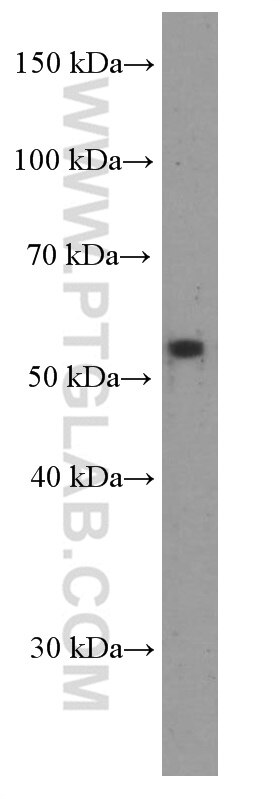RXRG Monoclonal antibody
RXRG Monoclonal Antibody for WB,ELISA
Host / Isotype
Mouse / IgG2b
Reactivity
human
Applications
WB,ELISA
Conjugate
Unconjugated
CloneNo.
1E7E5
Cat no : 66306-1-Ig
Synonyms
Validation Data Gallery
Tested Applications
| Positive WB detected in | A549 cells |
Recommended dilution
| Application | Dilution |
|---|---|
| Western Blot (WB) | WB : 1:1000-1:4000 |
| It is recommended that this reagent should be titrated in each testing system to obtain optimal results. | |
| Sample-dependent, Check data in validation data gallery. | |
Product Information
66306-1-Ig targets RXRG in WB,ELISA applications and shows reactivity with human samples.
| Tested Reactivity | human |
| Cited Reactivity | human |
| Host / Isotype | Mouse / IgG2b |
| Class | Monoclonal |
| Type | Antibody |
| Immunogen | RXRG fusion protein Ag1611 |
| Full Name | retinoid X receptor, gamma |
| Calculated Molecular Weight | 51 kDa |
| Observed Molecular Weight | 51 kDa |
| GenBank Accession Number | BC012063 |
| Gene Symbol | RXRG |
| Gene ID (NCBI) | 6258 |
| RRID | AB_2881688 |
| Conjugate | Unconjugated |
| Form | Liquid |
| Purification Method | Protein A purification |
| Storage Buffer | PBS with 0.02% sodium azide and 50% glycerol pH 7.3. |
| Storage Conditions | Store at -20°C. Stable for one year after shipment. Aliquoting is unnecessary for -20oC storage. 20ul sizes contain 0.1% BSA. |
Background Information
RXRG, also named as, Retinoic acid receptor RXR-gamma, is a 463 amino acid protein, which localize in the nucleus and may form homodimer. Retinoic acid receptors bind as heterodimers to their target response elements in response to their ligands, all-trans or 9-cis retinoic acid, and regulate gene expression in various biological processes. The RAR/RXR heterodimers bind to the retinoic acid response elements (RARE) composed of tandem 5'-AGGTCA-3' sites known as DR1-DR5.
Protocols
| Product Specific Protocols | |
|---|---|
| WB protocol for RXRG antibody 66306-1-Ig | Download protocol |
| Standard Protocols | |
|---|---|
| Click here to view our Standard Protocols |
Publications
| Species | Application | Title |
|---|---|---|


